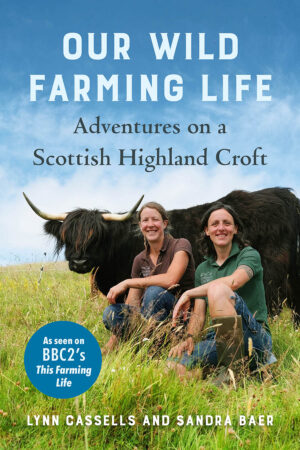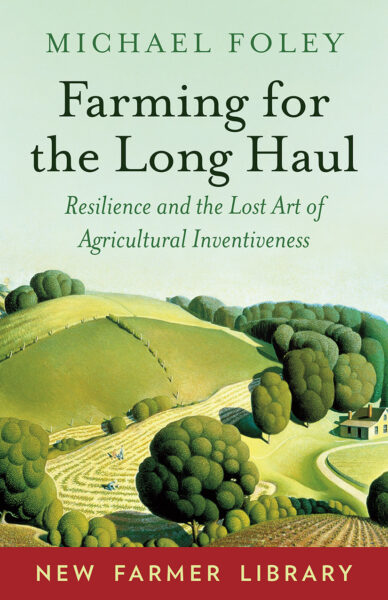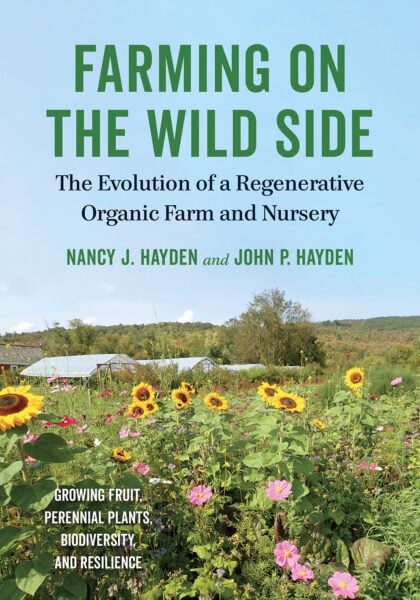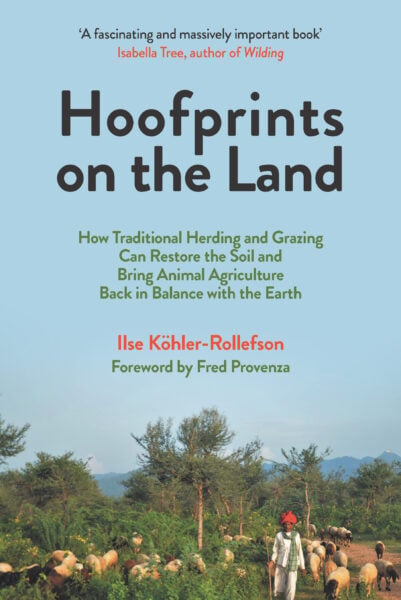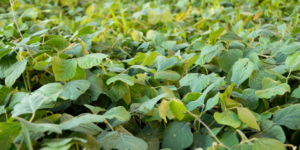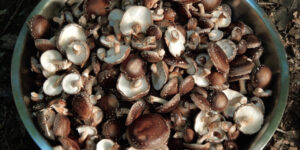Learning to Work With Nature: Finding Common Ground
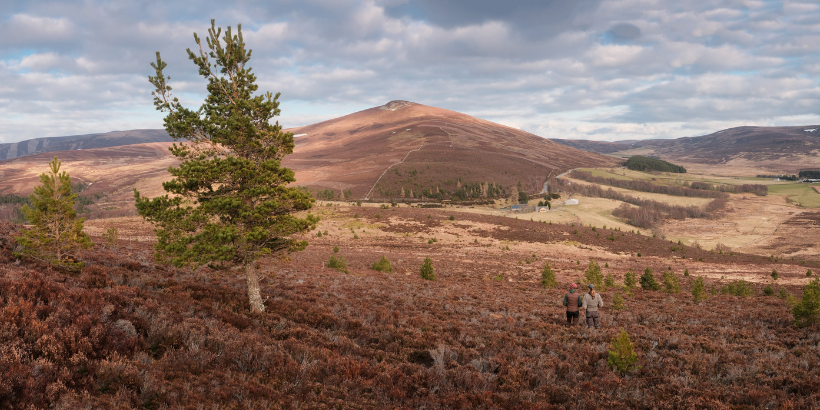
When Sandra Baer and Lynn Cassells founded Lynbreck Croft in Scotland, they had no money, no plan, and no experience in farming. But they did have a goal: to produce wonderful food for themselves and the people around them by learning to work with nature.
Through their efforts over the past several years, Sandra and Lynn have been able to combine regenerative farming practices with old crofting traditions to keep their own personal values intact. The ultimate key to their success was learning how to work in harmony with nature, thanks to advice from a few friends they met along the way.
To learn more about their journey, check out this article on how Sandra and Lynn became the farmers they are today.
The following is an excerpt from Our Wild Farming Life by Sandra Baer and Lynn Cassells. It has been adapted for the web.
Unless otherwise noted, all photos by Sandra Angers Blondin.
Working With Nature: Turning A Goal Into Reality
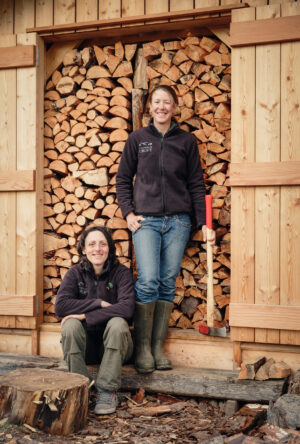 Roger and Gilly are a pioneering couple who run the Sailean Project on the Isle of Lismore off the west coast of Scotland. Lismore has a warmer, wetter climate and is formed on an elevated rocky outcrop of predominantly limestone, resulting in much more fertile soils. So, while the conditions there are actually quite different to Lynbreck, it was the closest working example in terms of farming approach and practices that we could find of what we were aspiring to do.
Roger and Gilly are a pioneering couple who run the Sailean Project on the Isle of Lismore off the west coast of Scotland. Lismore has a warmer, wetter climate and is formed on an elevated rocky outcrop of predominantly limestone, resulting in much more fertile soils. So, while the conditions there are actually quite different to Lynbreck, it was the closest working example in terms of farming approach and practices that we could find of what we were aspiring to do.
When we visited them at an open day in the summer of 2017, we learned that Roger used to be a large-scale arable farmer in Cambridgeshire, spending many years tilling the soil, dousing the land in chemicals to grow high-yielding crops that would deliver the biggest financial return, and, he’ll tell you himself, he did it very well and very successfully. After moving to Scotland to retire, the couple had no intention of getting back into farming but found themselves with land at Sailean and space for some hens, cattle and sheep.
Roger had also watched the documentary by Rebecca Hosking, something that caused him to face a crushing realisation of the damage he had done by farming an arable unit so intensively for many decades. From that point on, they committed their lives to running a new, diversified farm business based on holistic principles that would turn a profit, regenerate the soil and biodiversity, produce nutrient-dense food and educate others. We felt we had found kindred spirits in Roger and Gilly and, while their situation was very different, it was so exciting to find a real live working example in Scotland of the kind of farming we wanted to do.
Regenerative Agriculture: A New Kind Of Movement
Around the same time, we learned of a relatively new movement taking hold of the alternative agriculture world that was referred to as regenerative agriculture, a way of farming that regenerates the land and the communities that live on it. We started to read books by some of the leading figures in this new movement who, while critical of the industry to date, spoke with such passion and positivity about a different way of farming where everyone could benefit, if only we worked more with nature.
There is Joel Salatin from Polyface Farm in Virginia in the US, an entrepreneurial and hugely successful farmer with a big personality who talks openly about the state of food and farming today and is blessed with a way of communicating that presents complex science in layman’s terms using an engaging and accessible format. There is Richard Perkins from Ridgedale Farm who had bought a small land- holding in Sweden and within a few years transformed it into a highly efficient permaculture food production unit with a huge following and influence after sharing educational videos on his YouTube channel and running on-farm courses.
And then there is Allan Savory, a Zimbabwe national who became famous for his TED talk ‘How to Fight Desertification and Reverse Climate Change’ and talks passionately about his solution for regenerating landscapes through a framework he calls ‘holistic management’.
While they each had their different approaches and individual styles, they all talked of a world of farming that focuses on the importance of soil health, looking in particular at soil biology and working with livestock to help build even more soil and biodiversity, all embedded within a healthy, functioning social community. In our early days at Lynbreck, we attended a few farming events where soil and soil health were discussed at length but, according to the many experts we heard, true soil health would only be attainable with often substantial investment.
The Science Behind Soil
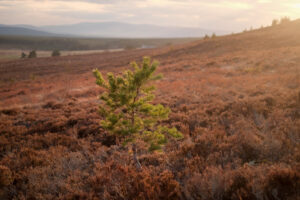 For many decades, the farming industry has focused on the chemistry of soil. Nitrogen, phosphorous and potassium, often referred to as NPK for short, are seen as the most important elements that need to be added to the soil regularly in the form of synthetic or natural fertiliser to keep the soil healthy and vegetation productive. At these talks, we were told that soils can be lacking in certain minerals so animals would need to be given these as supplements to avoid any deficiencies. The financial outlay for all of this was certainly starting to add up and we found ourselves questioning how soil, that forms the building blocks of all life, can be naturally deficient in anything?
For many decades, the farming industry has focused on the chemistry of soil. Nitrogen, phosphorous and potassium, often referred to as NPK for short, are seen as the most important elements that need to be added to the soil regularly in the form of synthetic or natural fertiliser to keep the soil healthy and vegetation productive. At these talks, we were told that soils can be lacking in certain minerals so animals would need to be given these as supplements to avoid any deficiencies. The financial outlay for all of this was certainly starting to add up and we found ourselves questioning how soil, that forms the building blocks of all life, can be naturally deficient in anything?
Or is it the repeated, intensive, invasive impact of humans that has caused the problems that we were now trying to cover with a technological sticking plaster, but not actually dealing with the deep wound beneath?
We would come home from these talks with our heads spinning, feeling bamboozled with the complexity and costs of what we were presented with. Sandra recalled a talk she had attended just after we moved to Lynbreck in 2016 by a lady called Christine Jones, an Australian soil ecologist who had talked at length about soil health, but with an emphasis on soil biology, not soil chemistry. In one of her many published papers, called ‘Light Farming’, she explains in simple language, the importance of harvesting the power of photosynthesis to build healthy soils and increase the profitability of a farm business, which did not require costly artificial inputs or supplements.
Christine explains that pasture farmers are actually solar farmers who capture sunlight via the leaves of the plants they grow and through the biological process of photosynthesis. This solar energy is turned into sugars, which are the building blocks of life. The sugars are then transformed into a number of carbon compounds, which are essential for creating topsoil and support a vast community of soil microbes. When there is a healthy microbial community that is connected to plants via a superhighway of underground fungal networks, plants are able to access the minerals and trace elements they need and these are, in turn, passed on to the animals that graze or browse them. And the way in which to create or maintain an optimum functioning soil biome is very simple: keep the soil covered, grow a diverse range of flora, avoid chemicals and integrate animals into the system.
In her paper, Christine is essentially giving us the choice to either regenerate or degenerate the land based on the decisions we make and the approach we take in our farming operations, explaining quite explicitly that soils are not deficient in anything if their biology is working at optimum level, and that is what we had to focus on.
Work With What You Got: Shaping the Lynbreck Landscape
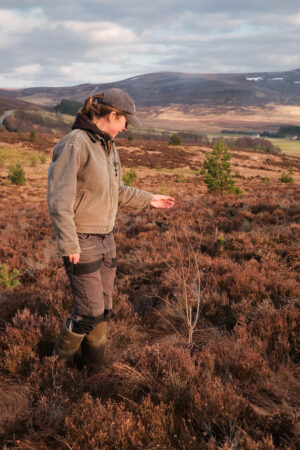 The more we read, watched and listened, the more our ideal of what a farmed Lynbreck landscape would look like took shape. Our business plan had already been approved but we were really starting to learn how we could turn a largely aspirational document into a real working model. The voices and working examples were few, but they were loud, powerful, compelling and inspiring, and we realised that if the regenerative path was for us, it was one we would have to carve out for ourselves. And while exciting, it was a prospect that initially felt overwhelmingly intimidating as our approach would take us against the advice of seasoned farmers, shunning the rhetoric of mainstream agricultural education and essentially going it alone.
The more we read, watched and listened, the more our ideal of what a farmed Lynbreck landscape would look like took shape. Our business plan had already been approved but we were really starting to learn how we could turn a largely aspirational document into a real working model. The voices and working examples were few, but they were loud, powerful, compelling and inspiring, and we realised that if the regenerative path was for us, it was one we would have to carve out for ourselves. And while exciting, it was a prospect that initially felt overwhelmingly intimidating as our approach would take us against the advice of seasoned farmers, shunning the rhetoric of mainstream agricultural education and essentially going it alone.
On one particular evening when doubts were gathering, as they so often did in those early setting up days, Sandra called Roger and Gilly for some advice, searching for the reassurance we were needing. In between lots of useful advice and encouraging words, Roger said, ‘Work with what you’ve got,’ a phrase that we revisit and repeat to ourselves to this day, adopting it as a baseline motto when we consider starting new ventures or trialling fresh approaches.
After the call, we began to brainstorm ‘what we had’, mind mapping a page of everything we could think of. We took a sheet of A4 paper and wrote ‘Lynbreck’ in the middle, drawing lines from the centre to key words and sentences: grasslands, woodlands, hill ground, bog, existing and planned buildings and infrastructure, personal skills and knowledge, community, our location. Soon the page was filled with a collection of physical, natural and cultural assets that combined gave us all the ingredients we needed for this new farming business.
Recommended Reads
Recent Articles
Want to see your crops thrive this upcoming growing season? The key is in soil fertility and health. Spend time maintaining your soil’s health to guarantee bigger and better crops come harvest time! The following is an excerpt from No-Till Intensive Vegetable Culture by Bryan O’Hara. It has been adapted for the web. What Is Soil Fertility?…
Read MoreMany know the effects of catnip on our feline friends, but few realize that catnip has medicinal effects for humans. From stomach aches to reducing fevers, catnip is a versatile herb with many benefits. The next time you grow this plant for your cat you may end up taking a few cuttings for yourself! The…
Read MoreIt’s time to take control of your seeds and become a plant breeder! Saving your seed allows you to grow and best traditional & regional varieties, and develop more of your own. The following excerpt is from Breed Your Own Vegetable Varieties by Carol Deppe. It has been adapted for the web. Becoming A Plant…
Read MoreTrying to figure out how to manage weeds in your garden beds? Use cover crops and living mulches for weed suppression while your garden flourishes! The following is an excerpt from The Ecological Farm by Helen Atthowe. It has been adapted for the web. Suppressing Weeds With Cover Crops: Getting Started Cover crops suppress weeds…
Read MoreInterested in becoming a mushroom farmer? Shiitake mushrooms are one of the easiest and most profitable places to start. The following is an excerpt from Farming the Woods by Steve Gabriel and Ken Mudge. It has been adapted for the web. (Photographs courtesy of Steve Gabriel and Ken Mudge unless otherwise noted.) The Stunning Shiitake…
Read More

